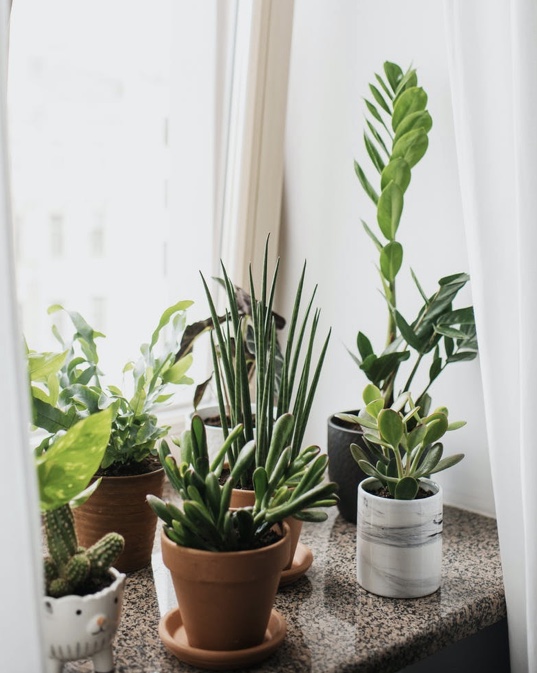Golden rule for dorm room plants: Keep it simple

COLUMBIA, Mo. — One way to spruce up a college dormitory room is to add plants, according to University of Missouri Extension horticulturist Michele Warmund.
Dorm rooms can appear a bit bare and dreary, Warmund says, but plants can add color and provide a pleasant atmosphere. “After spending the day in lecture halls, a plant-filled dorm room can be a nice place to study or relax with friends,” she says.
Dorm rooms are often small, so consider compact-growing plants that can be placed on a windowsill or desktop. Larger plants in a hanging basket can be suspended from the ceiling, if permitted by dorm regulations. In either case, use a container with an attached saucer on the bottom of the pot to make sure water doesn’t drip onto the floor and cause damage.
Consider the amount of available light. Cacti and succulent plants thrive in six or more hours a day of direct, bright light. Several types of foliage plants prefer indirect sunlight and are best placed slightly distanced from a south or west facing window to avoid sunburning the leaves. If plants can’t be placed near a window or the light is dim, use specialized grow lights for added illumination. For most indoor foliage plants, water once a week.
Small cacti and some succulent plants favor bright light, require little moisture and are ideal for the novice plant-grower, according to Warmund.
Warmund offers these recommendations:
Cacti
- Lady fingers or golden stars with elongated clumping stems that grow to about 4 inches. They have various colored spines in a spiral arrangement.
- Bird’s nest cactus has a solitary, globe-shaped form with six to nine spines grouped together in a star-like pattern at the pointed tips of the stem.
- Orange cob cactus has an olive-green, oval stem with short wispy spines arranged in columns.
- Chin or plaid cactus only grows about 2 inches tall. However, this bright red to orange cactus is often grafted on top of another cactus and is commonly called a moon cactus.
Succulents
Succulent plants are also a good option for a dorm room and appear less threatening since they lack the spines found on cacti.
- Zebra cactus, which is not actually a cactus, has variegated stems that grow in small clumps. This showy plant grows to about 5 inches tall and thrives in indirect light.
- Hens and chicks plants have thick, fleshy stems arranged in a rosette pattern. The main stem, known as the hen, produces small secondary rosettes called chicks. These plants, which require bright sunlight, grow about 3-6 inches tall and spread as much as 12 inches.
- Mexican hens and chicks, a different succulent plant with whitish-gray leaves, also grows in a clumping rosette form.
- Aloe vera is a tough succulent with long, spiny leaves; it grows best in direct light.
- The jade plant is another sun-loving plant. Multi-stemmed plants have fleshy, dark green foliage and can typically grow to 1-2 feet tall.
- Mother-in-law’s tongue or the snake plant has long, leathery green leaves with darker bands of color. While these plants typically reach up to 4 feet tall, a cultivar called Hahnii is a dwarf rosette form that grows to only 6 inches tall. These plants favor indirect light but also tolerate low light. Beware that all snake plants contain saponins, which are toxic to pets.
Foliage plants
For a more tropical atmosphere, there are several foliage plants that grow well in a dorm room, though they require a bit more space than many cacti or succulents.
- Lucky bamboo can be grown in a potting mix or chlorine-free water in a vase in indirect light. Its upright, leafy stems can grow in a natural position or be trained to form various shapes.
- Parlor palm is very tolerant of low light and is found in 2.5 or 4 inch pots from local retailers.
- Other plants that grow well in pots or hanging baskets include wax plants, heart-leaf philodendron, pothos and wandering dude. Spider plant is yet another fun plant that produces new plantlets on drooping, elongated stems.
Plants from a reliable source generally have few pest problems, Warmund says. Tip burn on leaves may be caused by low humidity, excessively dry potting mix and salt accumulation from water or fertilizer. Use distilled water to prevent tip browning caused by fluoride and chlorine in tap water.
Miss Clipping Out Stories to Save for Later?
Click the Purchase Story button below to order a print of this story. We will print it for you on matte photo paper to keep forever.

